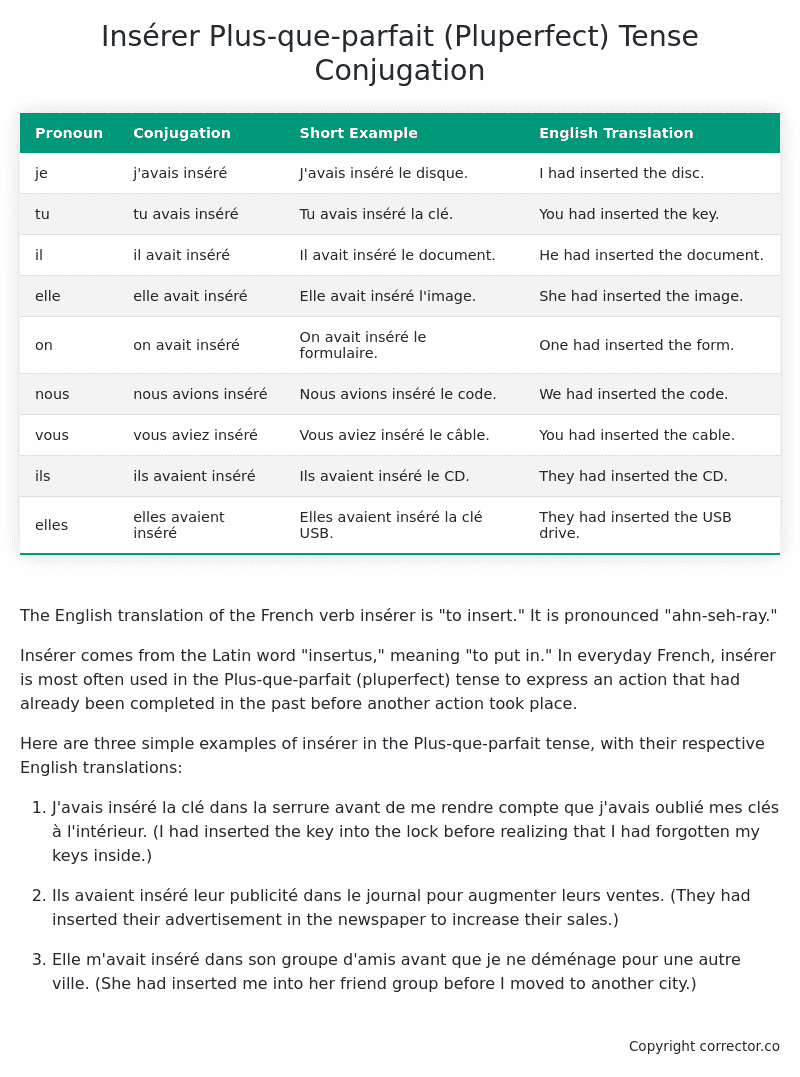Plus-que-parfait (Pluperfect) Tense Conjugation of the French Verb insérer
Introduction to the verb insérer
The English translation of the French verb insérer is “to insert.” It is pronounced “ahn-seh-ray.”
Insérer comes from the Latin word “insertus,” meaning “to put in.” In everyday French, insérer is most often used in the Plus-que-parfait (pluperfect) tense to express an action that had already been completed in the past before another action took place.
Here are three simple examples of insérer in the Plus-que-parfait tense, with their respective English translations:
-
J’avais inséré la clé dans la serrure avant de me rendre compte que j’avais oublié mes clés à l’intérieur. (I had inserted the key into the lock before realizing that I had forgotten my keys inside.)
-
Ils avaient inséré leur publicité dans le journal pour augmenter leurs ventes. (They had inserted their advertisement in the newspaper to increase their sales.)
-
Elle m’avait inséré dans son groupe d’amis avant que je ne déménage pour une autre ville. (She had inserted me into her friend group before I moved to another city.)
Table of the Plus-que-parfait (Pluperfect) Tense Conjugation of insérer
| Pronoun | Conjugation | Short Example | English Translation |
|---|---|---|---|
| je | j’avais inséré | J’avais inséré le disque. | I had inserted the disc. |
| tu | tu avais inséré | Tu avais inséré la clé. | You had inserted the key. |
| il | il avait inséré | Il avait inséré le document. | He had inserted the document. |
| elle | elle avait inséré | Elle avait inséré l’image. | She had inserted the image. |
| on | on avait inséré | On avait inséré le formulaire. | One had inserted the form. |
| nous | nous avions inséré | Nous avions inséré le code. | We had inserted the code. |
| vous | vous aviez inséré | Vous aviez inséré le câble. | You had inserted the cable. |
| ils | ils avaient inséré | Ils avaient inséré le CD. | They had inserted the CD. |
| elles | elles avaient inséré | Elles avaient inséré la clé USB. | They had inserted the USB drive. |
Other Conjugations for Insérer.
Le Present (Present Tense) Conjugation of the French Verb insérer
Imparfait (Imperfect) Tense Conjugation of the French Verb insérer
Passé Simple (Simple Past) Tense Conjugation of the French Verb insérer
Passé Composé (Present Perfect) Tense Conjugation of the French Verb insérer
Futur Simple (Simple Future) Tense Conjugation of the French Verb insérer
Futur Proche (Near Future) Tense Conjugation of the French Verb insérer
Plus-que-parfait (Pluperfect) Tense Conjugation of the French Verb insérer (this article)
Passé Antérieur (Past Anterior) Tense Conjugation of the French Verb insérer
Futur Antérieur (Future Anterior) Tense Conjugation of the French Verb insérer
Subjonctif Présent (Subjunctive Present) Tense Conjugation of the French Verb insérer
Subjonctif Passé (Subjunctive Past) Tense Conjugation of the French Verb insérer
Subjonctif Imparfait (Subjunctive Imperfect) Tense Conjugation of the French Verb insérer
Subjonctif Plus-que-parfait (Subjunctive Pluperfect) Tense Conjugation of the French Verb insérer
Conditionnel Présent (Conditional Present) Tense Conjugation of the French Verb insérer
Conditionnel Passé (Conditional Past) Tense Conjugation of the French Verb insérer
L’impératif Présent (Imperative Present) Tense Conjugation of the French Verb insérer
L’infinitif Présent (Infinitive Present) Tense Conjugation of the French Verb insérer
Struggling with French verbs or the language in general? Why not use our free French Grammar Checker – no registration required!
Get a FREE Download Study Sheet of this Conjugation 🔥
Simply right click the image below, click “save image” and get your free reference for the insérer Plus-que-parfait tense conjugation!

Insérer – About the French Plus-que-parfait (Pluperfect) Tense
Tense Formation
Common everyday usage patterns
Sequencing of past events
Background information
Hypothetical or reported speech
Interactions with other tenses
Summary
I hope you enjoyed this article on the verb insérer. Still in a learning mood? Check out another TOTALLY random French verb conjugation!


